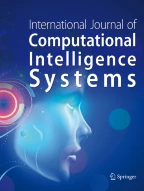54Accesses
Abstract
In this paper, we investigate the cluster techniques of hesitant fuzzy information. Consider that the distance measure is one of the most widely used tools in clustering analysis, we first point out the weakness of the existing distance measures for hesitant fuzzy sets (HFSs), and then put forward a novel distance measure for HFSs, which involves a new hesitation degree. Moreover, we construct the distance matrix and choose different values ofλ so as to obtain theλ- cutting matrix, each column of which is treated as a vector. After that, an orthogonal clustering method is developed for HFSs. The main idea of this clustering method is that the orthogonal vectors in the distance matrix should be clustered into the same group, and according to the different values ofλ, the procedure will repeat again and again until all the cases are considered. Finally, two numerical examples are given to demonstrate the effectiveness of our algorithm.
Article PDF
Explore related subjects
Discover the latest articles, news and stories from top researchers in related subjects.Avoid common mistakes on your manuscript.
References
L. A. Zadeh. Fuzzy sets. Inform and control 8 (1965) 338–353
K. Atanassov. Intuitionistic fuzzy sets. Fuzzy Sets and Systems 20 (1986) 87–96
K. Atanassov and G. Gargov. Interval-valued intuitionistic fuzzy sets. Fuzzy Sets and Systems 31 (1989) 343–349
D. Dubois and H. Prade. Fuzzy Sets and Systems: Theory and Applications. New York: Academic Press, 1980
S. Miyamoto. Remarks on basics of fuzzy sets and fuzzy multisets. Fuzzy Sets and Systems 156 (2005) 427–431
J.M. Mendel, R.I. John and F. Liu. Interval type-2 fuzzy sets made simple. IEEE Transactions on Fuzzy Systems 14 (6) (2006) 808–821
V. Torra. Hesitant Fuzzy Sets. International Journal of Intelligent Systems 25 (2010) 529–539
V. Torra and Y. Narukawa. On hesitant fuzzy sets and decision. The 18th IEEE International Conference on Fuzzy Systems, Jeju Island, Korea, 2009, 1378–1382
M.M. Xia and Z.S. Xu. Hesitant fuzzy information aggregation in decision making. International Journal of Approximate Reasoning 52 (2011) 395–407
Z.S. Xu and M.M. Xia. Distance and similarity measures for hesitant fuzzy sets. Information Sciences 181 (2011) 2128–2138
R. M. Rodríguez, L. Martínez, V. Torra, Z.S. Xu and F. Herrera, “Hesitant fuzzy sets: State of the art and future directions”, International Journal of Intelligent Systems, vol. 29, no. 6: Wiley, pp. 495–524, 2014
H.C. Liao, Z.S. Xu and X.J. Zeng. Distance and similarity measures for hesitant fuzzy linguistic term sets and their application in multi-criteria decision making. Information Sciences 271 (2014) 125–142
Z.S. Xu. Hesitant Fuzzy Sets Theory. Berlin, Heidelberg: Springer-Verlag, 2015
R. M. Rodríguez, B. Bedregal, H. Bustince, Y. Dong, B. Farhadinia, C. Kahraman, L. Martínez, V. Torra, Y.J. Xu, Z.S. Xu, et al., “A Position and Perspective Analysis of Hesitant Fuzzy Sets on Information Fusion in Decision Making. Towards High Quality Progress”, Information Fusion, vol. 29, pp. 89–97, 2016
E. Szmidt and J. Kacprzyk. A similarity measure for intuitionistic fuzzy sets and its application in supporting medical diagnostic reasoning. The 7th International Conference on Artificial Intelligence and Soft Computing. Zakopane, 2004, 388–393
D. F. Li and C. T. Cheng. New similarity measures of intuitionistic fuzzy sets and application to pattern recognitions. Pattern Recognition Letters 23 (2002) 221–225
C.C. Wong and H.R. Lai. A grey-based clustering algorithm and its application on fuzzy system design. International Journal of Systems Science 34 (2003) 269–281
B. Everitt, S. Landau and M. Leese. Cluster Analysis, 4th edition, London: Arnold 2001
C. Alzate and J.A.K. Suykens. Hierarchical kernel spectral clustering, Neural Networks, 35 (2012) 21–30
K. Polat. Classification of Parkinson’s disease using feature weighting method on the basis of fuzzy C-means clustering. International Journal of Systems Science. 43 (2012)) 597–609
X.L. Zhang and Z.S. Xu. Hesitant fuzzy agglomerative hierarchical clustering algorithms. International Journal of Systems Science. 46 (2013)) 562–576
N. Chen, Z.S. Xu and M.M. Xia. Correlation coefficients of hesitant fuzzy set and their applications to clustering analysis. Applied Mathematical Modelling 37 (2013) 2197–2211
X.L. Zhang and Z.S. Xu. A MST clustering analysis method under hesitant fuzzy environment. Control and Cybernetics 41 (2012) 645–666
S. Miyamoto. Fuzzy sets in information retrieval and cluster analysis. Dordrecht: Kluwer, 1990: 181–192
N. Chen, Z.S. Xu and M.M. Xia. Hierarchical hesitant fuzzy K-means clustering algorithm. Applied Mathematics-A Journal of Chinese Universities 2014,29(1):1–17
D. Q. Li, W. Y. Zeng and J. H. Li. New distance and similarity measures on hesitant fuzzy sets and their applications in multiple criteria decision making. Engineering Applications of Artificial Intelligence 40 (2015) 11–16
X.D. Liu, J. J. Zhu, S.F. Liu. Similarity measure of hesitant fuzzy sets based on symmetric cross entropy and its application in clustering analysis. Control and Decision 29 (2014) 1816–182
Author information
Authors and Affiliations
Institute of Sciences, PLA University of Science and Technology, 211101, Nanjing, Jiangsu, China
Yanmin Liu & Hua Zhao
Business School, Sichuan University, 610064, Chengdu, Sichuan, China
Zeshui Xu
- Yanmin Liu
You can also search for this author inPubMed Google Scholar
- Hua Zhao
You can also search for this author inPubMed Google Scholar
- Zeshui Xu
You can also search for this author inPubMed Google Scholar
Corresponding author
Correspondence toYanmin Liu.
Rights and permissions
This is an open access article under the CC BY-NC license (http://creativecommons.org/licenses/by-nc/4.0/).
About this article
Cite this article
Liu, Y., Zhao, H. & Xu, Z. An orthogonal clustering method under hesitant fuzzy environment.Int J Comput Intell Syst10, 663–676 (2017). https://doi.org/10.2991/ijcis.2017.10.1.44
Received:
Accepted:
Published:
Issue Date:
Share this article
Anyone you share the following link with will be able to read this content:
Sorry, a shareable link is not currently available for this article.
Provided by the Springer Nature SharedIt content-sharing initiative
